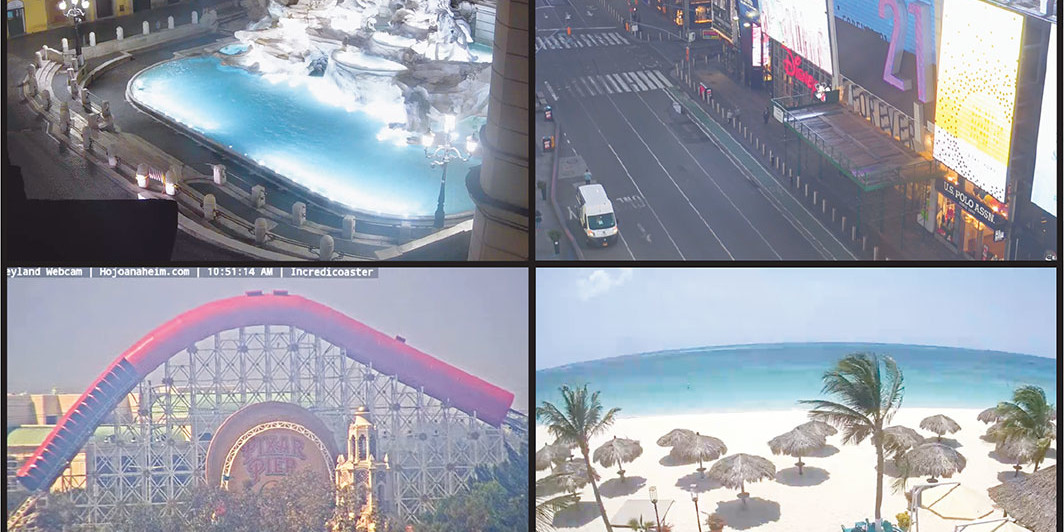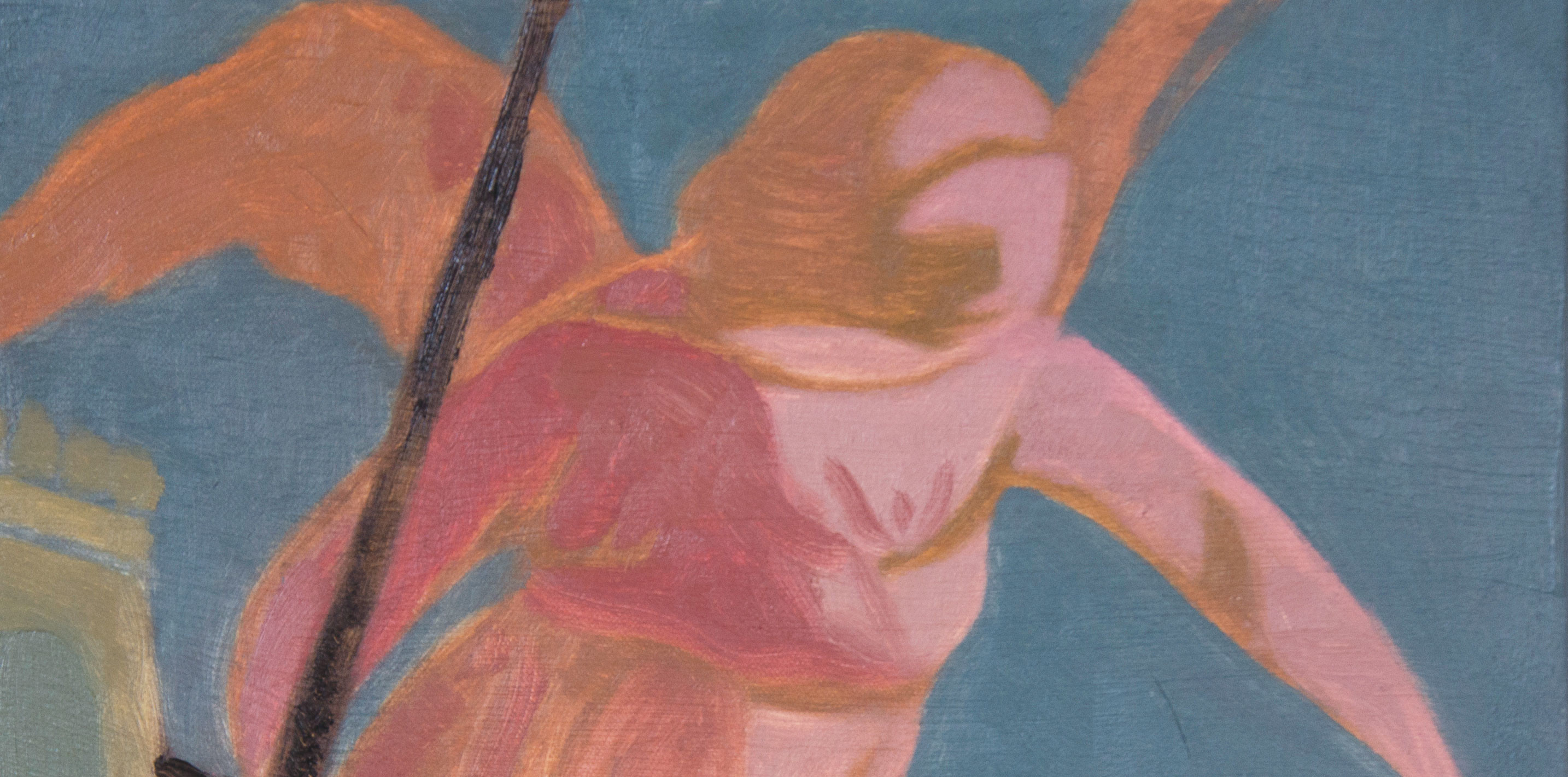AT FIVE THIRTY on a perfect spring evening, there is no one at the Trevi Fountain. The last strips of sunlight slide between apartment buildings and the water gurgles a bright, calming blue. There is only splashing, and pigeons. Not a soul is at the Pantheon, or milling around the Piazza di Spagna, at the base of the Spanish Steps. The Acropolis is absolutely still. A giant neon arrow on the Las Vegas Strip points down to an empty street. Someone has written “Hola” in large letters in the sand in the Canary Islands, but they’ve since gone. Miles of
- print • Summer 2020
- print • Summer 2020
LATELY, FOR OBVIOUS REASONS, I’ve been preoccupied with suffering and death—when I’m following the news of the pandemic, but also in my daily meditation practice, which involves chanting, sitting Zen, and reading from stacks of Buddhist books I keep handy next to my cushion. In the past few days I’ve read the chapters on death and rebirth in Tsongkhapa’s encyclopedic Lamrim Chenmo, or The Great Treatise on the Stages of the Path to Enlightenment, a book so beloved that the Dalai Lama kept a copy hidden in his robes when he fled Lhasa in 1959.
- print • Summer 2020
I REALIZED WHEN I WAS AROUND EIGHT THAT THE VERY CONCEPT OF HELL IS INSANE AND EVIL, and never looked back. I don’t regard this as an especially precocious perception—many other Christians I have known report a similar experience.
- print • Summer 2020
Gillian Haratani in a Bernadette Corporation look, 1996. From Fashion Work 1993–2018: 25 Years of Art in Fashion. Cris Moor But is it art, or fashion? In FASHION WORK 1993–2018: 25 YEARS OF ART IN FASHION (Damiani, $45), Danish-born curator and critic Jeppe Ugelvig offers a refreshing take: that this question should not be framed […]
- print • Summer 2020
The titles of Thaddeus Mosley’s recent wood sculptures are often plainly descriptive: There’s a curve in Curved Closure, branches in Branched Form, and an oval in Oval Continuity. This straightforward denotation of the works’ spatial and geometric character indicates Mosley’s matter-of-fact approach. At ninety-four, the self-taught artist isn’t inclined toward mystification or obscurity. In an essay by curator Brett Littman, included in this volume, Mosley recounts how in the 1950s he saw “decorative furniture with details like small birds and fish made out of wood” in a Pittsburgh department store. “They wanted a fortune for those pieces, so instead I
- print • Summer 2020
It’s the second week of March in Paris, and COVID-19 still hasn’t shut the city down. I am staying at the Hotel La Louisiane, the haunt of Jean-Paul Sartre, Simone de Beauvoir, Charlie Parker, Miles Davis, Cy Twombly, and more—an oddball historic dive in the heart of the Sixth Arrondissement. I spend my days retracing the steps of literary and art icons and reading in cafés. I’ve been asked to write about The Heart, Marc Petitjean’s new book about Frida Kahlo’s life in Paris in 1939, and it seems to haunt me at every step. I walk over the Seine
- print • Summer 2020
For many of its participants, the women’s liberation movement represented a saving break with an unremittingly bleak past. A switch flipped at the end of the 1960s, and the culture flooded with light. Where once there had been only darkness—Ladies’ Home Journal, back-alley abortions, MRS degrees—now there was feminism: Kate Millett made the cover of Time, Shirley Chisholm made the ballot, and young women picketed bridal fairs and beauty pageants that they might have attended a year before. In 1971, fiction writer Tillie Olsen remarked with awe that “this movement in three years has accumulated a vast new mass of
- print • Summer 2020
“In Athens, Georgia, in the 1980s, if you were young and willing to live without much money, anything seemed possible,” Grace Elizabeth Hale opens her new book Cool Town, about how the B-52s, R.E.M., Vic Chesnutt, and scads of lesser-known alternative-rock artists sprang out of one small southern college town four decades ago. My first impulse was to substitute the line Tolstoy might have written if Tolstoy had been really into rock bands: All local music scenes are the same, but every music scene is local in its own way. Young people coalesce around a few emerging performers or spaces
- print • Summer 2020
In Murals of New York City, all of the Big Apple’s bygone eras seem to blend together. On the walls of Neoclassical courthouses and Art Deco airports, hallowed hotel bars and brick borough halls, we see the Rockefellers and Roosevelts still running things, and the Astaires, the Barrymores, and the Fitzgeralds forever flitting around. People smoked in restaurants, and artists—apparently—had studios in the attic of Grand Central Terminal. Graffiti didn’t yet have a name. The New School was still new, as was the New Deal. The Works Progress Administration paid for everything. It’s the Gilded Age, and the Jazz one,
- print • Summer 2020
A few months ago, the thirtieth-anniversary republication of a book written at the peak of the HIV epidemic and chronicling the impact of the virus on an intimate social circle of French writers, artists, medical professionals, and intellectuals—Michel Foucault among them—might have been a boutique or scholarly curiosity. AIDS, after all, has become one of the few medical and socio-biological “success” stories of recent decades. Testing plus an effective cocktail of antiretroviral drugs, alongside newer prophylactic treatments like Truvada, has reduced the illness to a chronic condition rather than a death sentence. In so-called advanced nations, the disease is mostly
- print • Summer 2020
For all his love of Dante, I don’t think Nick Tosches was much of a Boccaccio man. Still, he might have admired the saga that begins The Decameron. It is the story of one Ser Cepparello da Prato, un pessimo uomo, a dandy gentleman who wets his beak in every vice—blasphemy, forgery, booze, sex, crooked dice, marked cards, you name it. But nothing gives him a bigger kick than stirring up bad feelings, for, according to our storyteller, “the greater the evils he saw . . . the greater his happiness.” Dispatched to Burgundy to collect on the Boss’s loans,
- print • Summer 2020
A FEW NIGHTS AGO, I WAS VISITED BY AN EMAIL. Back before the world gasped, my brother, the doctor, hardly ever wrote me anything beyond a “dinner Friday y/n,” and yet here he was, in the breathless thick of it, attaching a file of 7,241 words. I’d thought that he was far out in the boroughs intubating the sick or putting them through dialysis—and he was—but somehow he’d also found the time and adrenalized energy to put more language down on the screen than I, the ostensible writer, had managed to eke out in weeks, even months. The instructions that
- excerpt • April 30, 2020
What’s the opposite of nostalgia? I ask that question because the stories in this book take me back to a time & place I thought I’d forgotten—but I really wouldn’t want to go back there.
- excerpt • April 28, 2020
The cultural critic Susan Sontag’s classic Illness as Metaphor emerged from her rage at seeing, after her own cancer diagnosis, “how much the very reputation of this illness added to the suffering of those who have it.” In 1978, Sontag contended with cancer’s reputation as scourge, invader, predator, demonic pregnancy, demonic enemy, barbarian within. Cancer’s roots were then imagined, at least in part, as psychological, resulting from repressed emotion. These metaphoric conceptions of cancer saddled its sufferers with shame and prevented many from seeking proper treatment or even knowing their diagnosis. A decade later, in AIDS and Its Metaphors, Sontag
- review • April 16, 2020
Social distancing may have brought us farther from our friends, but we have never been in more constant contact with our bookshelves and word processors. Many of us are dusting off unread classics, or attempting to write the book we’ve always meant to. Though they aren’t physically open, universities, literary institutions, and bookstores are providing online classes and community events on literature and composition. Grab your Milton and open “Novel.doc”—the experts are (virtually) in.
- review • April 9, 2020
Reading at home can’t replace the sense of community and connection offered at your local bookstore, but virtual book clubs, talks, and classes may help fill the void. Independent booksellers and publishers across the US are moving their scheduled spring programming online and some are launching entirely new web series for your quarantine-viewing pleasure. Attending these won’t be the same as meeting in person, but it’ll come close.
- print • Apr/May 2020
Benny and Josh Safdie, Uncut Gems, 2019. Howard Ratner (Adam Sandler). A24 We were called hip-pocketers, because we lived from one deal to the next: Your business could fit in the wallet in your pocket. You bought a used Rolex at a pawnshop for a thousand bucks from the kid who’s just paid five hundred […]
- print • Apr/May 2020
Do you find it as obvious as I do that Don DeLillo richly deserves to receive the Nobel Prize in Literature? And right away, as in this year?
- print • Apr/May 2020
Deacon King Kong (Riverhead, $28) is a warm-blooded free-for-all, a donnybrook, a rumpus, what in baseball lingo would be called a “rhubarb.” And, as it happens, baseball, a steadfast metaphor for democratic ideals, plays a marginal role in James McBride’s bountiful and compassionate comedy of errors, bloopers, and near misses. The generosity of detail and range of emotional life infused in McBride’s vision of working-class Brooklyn at the hinge of the 1960s and 1970s are more characteristic of a nineteenth-century novel than of its counterparts in the twenty-first. And McBride is so adroit at manipulating his characters through myriad complications
- print • Apr/May 2020
Davide Sorrenti excelled at the part of photography that takes place long before a camera comes into play. He got people to relax, to be vulnerable and unselfconscious. (To be naked, too, sometimes.) Small and young and rapscallionish, he slid into complicated situations with ease, arrogance, and poise. He was the sort of photographer people in front of the lens wanted to please, because in his big-ego, small-package cocksureness, he seemed privy to some idea of beauty or freedom that maybe, if you let him snap the picture, you might access too.



















